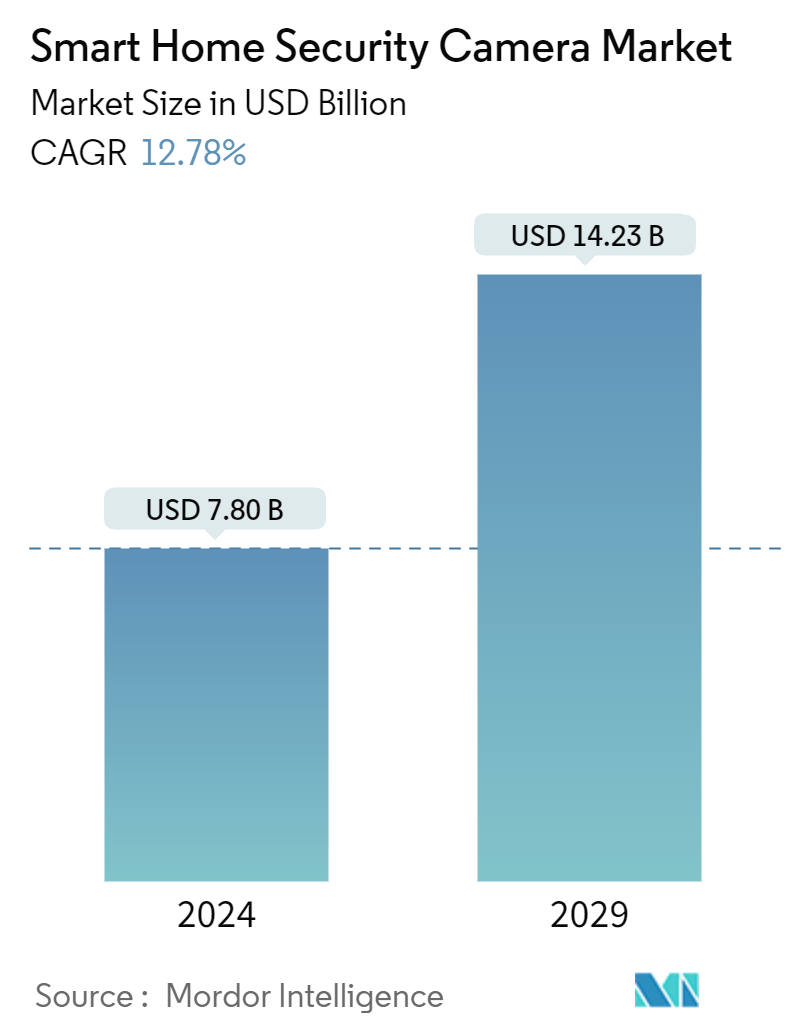Market Size of Smart Home Security Camera Industry

| Study Period | 2024 - 2029 |
| Market Size (2024) | USD 7.80 Billion |
| Market Size (2029) | USD 14.23 Billion |
| CAGR (2024 - 2029) | 12.78 % |
| Fastest Growing Market | North America |
| Largest Market | Asia Pacific |
Major Players
*Disclaimer: Major Players sorted in no particular order |
Smart Home Security Camera Market Analysis
The Smart Home Security Camera Market size is estimated at USD 7.80 billion in 2024, and is expected to reach USD 14.23 billion by 2029, growing at a CAGR of 12.78% during the forecast period (2024-2029).
- The demand for smart home security camera systems is driven by the surging adoption of smart homes, where smart camera systems are integral. Also, increasing awareness about home security leads to increasing the adoption of IP (Internet Protocol) cameras in security systems. In recent years, the use of IP (Internet Protocol) security cameras has increased due to the need for clear image quality and perimeter monitoring. Key global technologies include CCTVs, command and control systems, private LTE communication, data storage, automatic number plate recognition (ANPR), video analytics, and related ICT equipment. These technologies have helped implement intelligent cameras.
- Integrating AI with advanced video technology is a significant advancement in home security. For instance, Brinks Home's security cameras, powered by AI, blend high-quality detection capabilities with high-resolution visuals, recording clear video footage in various lighting conditions. Furthermore, the company's advanced indoor and outdoor cameras provide video analysis with object detection as an advanced attribute. Such developments, coupled with the growing need to secure homes with smart cameras that offer innovative solutions by integrating advanced technologies and continuous innovations from market vendors regarding resolution, will shape the market's growth in the coming years.
- Smart home security cameras usually incur high costs due to deploying advanced systems. In addition, the market's growth is hindered by increasing cybersecurity worries related to their use. Weak SSIDs or passwords and vulnerable encryption methods can put Wi-Fi at risk of being compromised. Using default login credentials, hackers can easily access a router. A strong Wi-Fi password can force hackers to find more complex ways to infiltrate the network, thus impeding the market's growth.
- The macroeconomic factor that is anticipated to influence the studied market's growth is the US-China trade dispute. A further escalation of this issue may have a notable impact on the pricing of smart home security cameras, as China is among the major suppliers of components and a central manufacturing hub for these devices. In recent years, the United States has imposed restrictions on China's access to advanced technologies, which stresses the supply chain. For instance, in August 2023, the United States government passed an executive order to prevent US firms' new investments in China in sensitive technologies like computer chips and require government notification in other tech sectors.

